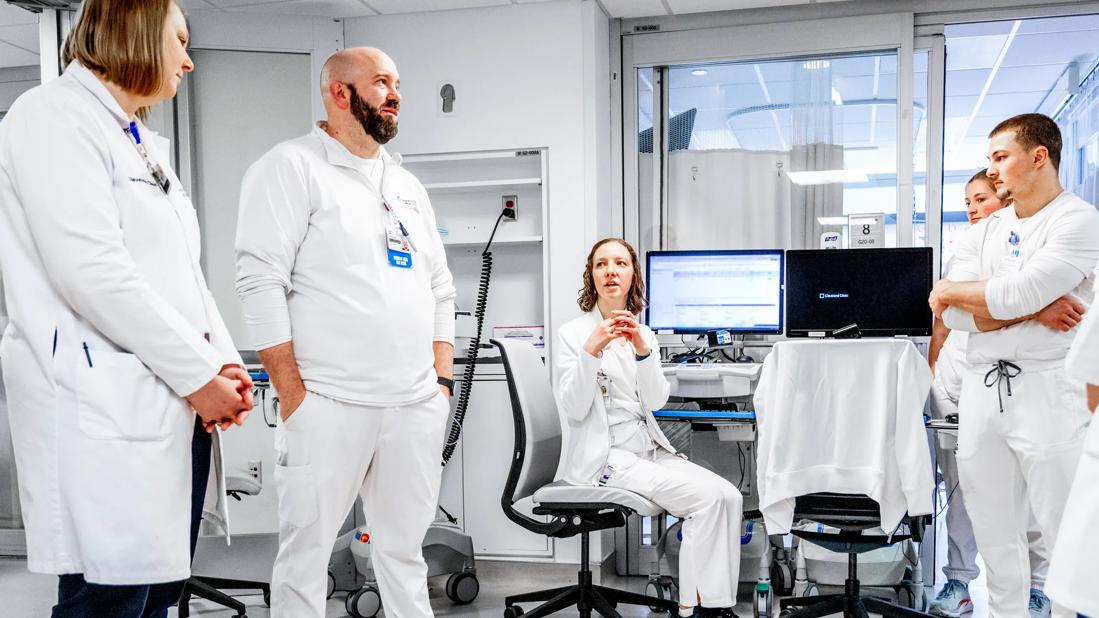Experts offer hands-on support and education

When nurses on a colorectal surgery unit at Cleveland Clinic Main Campus had questions about appropriate nursing interventions for patients with nasogastric (NG) tubes, they reached out to Clinical Nurse Specialist (CNS) Erica Collins, MSN, APRN, AGCNS-BC. She contacted Hannah Durant, MSN, RN, Nursing Professional Development Specialist (NPDS), to help develop a plan to educate caregivers on the unit.
Advertisement
Cleveland Clinic is a non-profit academic medical center. Advertising on our site helps support our mission. We do not endorse non-Cleveland Clinic products or services. Policy
Collins and Durant rounded on the colorectal surgery unit during day and night shifts to highlight key interventions and created a flier with do’s and don’ts for NG tube care, which they later disseminated to other nursing units across Main Campus.
Teaming up to support caregivers is routine for Collins and Durant, who began collaborating four years ago.
“We work together to provide real-time clinical guidance and education for nurses, making a positive impact on nursing practice and driving high-quality patient care,” says Collins.

Collins and Durant advocate for collaboration between a CNS and NPDS on nursing units, noting that the roles are complementary. Clinical nurse specialists mentor caregivers, implement evidence-based practice and assist in direct patient care. Nursing professional development specialists assess caregivers’ learning competencies, strengths and opportunities, then provide education to meet ongoing needs.
“When we’re working together on a unit, I provide clinical knowledge and advanced practice skills nurses can use at the bedside, and Hannah comes in with educational resources the nurses can use now and in the future,” says Collins.
The experts routinely conduct rounds on two colorectal surgery units. Sometimes they cover specific topics suggested by nursing leaders on the unit, while other times they let nurses guide the discussion.
“These informal rounds where we don’t have a set topic are often very meaningful,” says Durant. “The nurses bring up issues that are on their minds or concerns about one of their patients. We help them critically think through the plan of care.”
Advertisement
In 2022 and 2023, Collins and Durant conducted 75 collaborative rounds and engaged with nearly 250 nursing caregivers.
Collins and Durant frequently address quality metrics. They participate in CLABSI and CAUTI rounds.
“We may come across an occluded central line or a patient that requires a specialty dressing,” says Collins. “I can assist the nurses with complex patient care, and Hannah ensures they have the tools for central line maintenance and our CLABSI prevention bundle.”
During CAUTI rounds, Durant identified a need for education related to perineal care and catheter care. She performed real-time education with patient care nursing assistants and other unlicensed assistive personnel, while Collins reviewed line necessity with clinical nurses on the unit.
“We reviewed the overarching importance of performing these key infection prevention measures for our patients,” says Durant.
Although many factors contribute to infection prevention, one of the colorectal units has decreased CLABSI rates by 50% since Collins and Durant began their collaborative rounding.
Developing tools and resources, such as the flier on NG tube care, is also an important component of partnership between Collins and Durant. They created an agency nurse resource binder with policies, procedures and best practices that was circulated throughout the Cleveland Clinic health system. They also developed one-page handouts with their contact information, photos, descriptions of the CNS and NPDS roles, and a list of ways each of them can assist caregivers.
Advertisement
“We want nurses to know that even when we aren’t on the unit, we are always available and encourage them to reach out to us,” says Collins. “We want them to feel safe and open coming to us with any questions they have because that’s how everyone improves.”
The benefits of the partnership extend beyond the units. “Our collaboration strengthens our individual roles, too,” says Durant. “I can be a stronger nursing professional development specialist having Erica as a resource.”
She and Collins presented a poster at the 2024 Academy of Medical-Surgical Nurses convention entitled, “Unite and Build: A Collaborative Relationship of a CNS and NPDS That Supports Medical-Surgical Units.” Several attendees expressed interest in the concept, including a nursing director from a Midwestern hospital who reached out to learn more about the collaboration.
Collins and Durant offer several tips for clinical nurse specialists and nursing professional development specialists who want to form effective collaborations:
Advertisement
Working in tandem as a CNS/NPDS team has increased nurse engagement and enhanced professional skills.
“The united presence that we offer helps bridge the gap between education and practical application on the unit,” says Durant.
Advertisement
Advertisement

Compassion, communication and critical thinking are key

How hospitals can weave ethics into daily nursing practice to strengthen patient-centered care

Guiding nurses amid a constantly evolving healthcare landscape

Ideation session generates solutions to medication administration errors

Caregivers spearhead changes that improve patient care, shape hospital culture

Building a culture that supports, engages and empowers nursing staff

Nurses harness cutting-edge technology as a bridge to healing

Optimizing care while protecting patients from life-threatening reactions